The spinal muscles and ligaments work in conjunction to help support the spine, maintain an upright posture, and control movements during activity and rest. The muscles are named based on shape, location, or combination. Further categorization factors include muscle functions like flexion, extension, or rotation. Skeletal muscle is a form of striated muscle tissue that is voluntarily controlled by the somatic nervous system. Striated means it is striped in appearance. Most skeletal muscles are attached to bones by collagen fibers known as tendons.
| Vertebral Muscle Types | Location |
| Forward flexors | Anterior |
| Lateral flexors | Lateral |
| Rotators | Lateral |
| Extensors | Posterior |
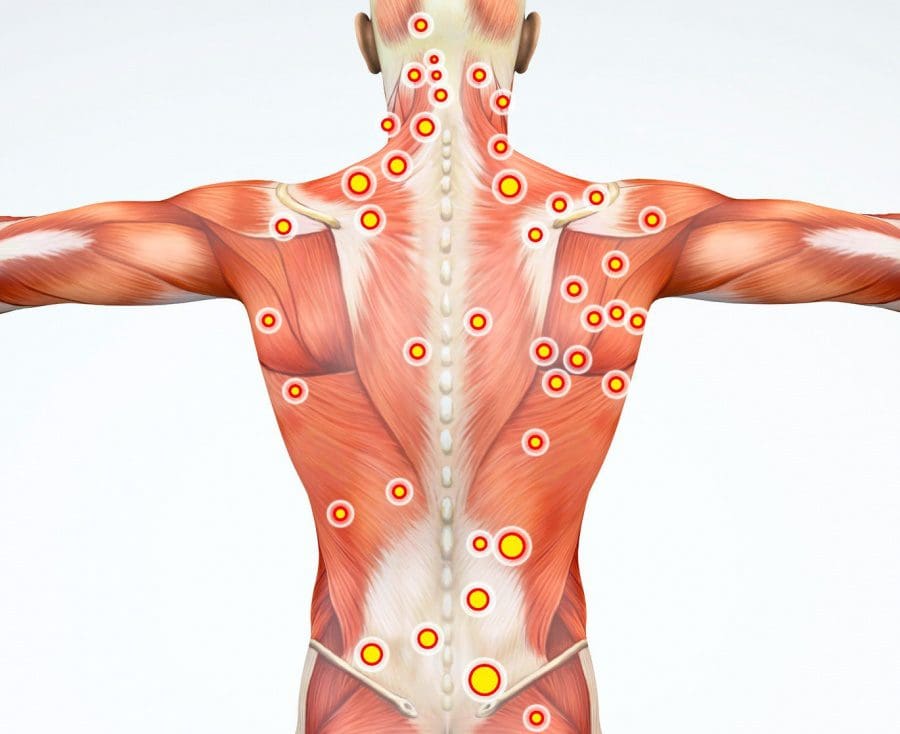
It has the fastest contraction rate of all muscles. Before muscle/s contracts, a nerve impulse starts in the brain and runs through the spinal cord to the muscle. For the muscles to contract and work properly, they need energy/fuel. Mitochondria produce Adenosine triphosphate chemical cells that are needed for energy. Adenosine triphosphate is made as the mitochondria burn glucose or sugar. The blood vessels deliver the oxygen and nutrients the mitochondria need to maintain a steady supply of adenosine triphosphate.
Table of Contents
The Posterior Cervical and Upper Thoracic Spinal Muscles
- Semispinalis Capitus – controls the head rotation and backward pulls
- Iliocostalis Cervicis – extends the cervical vertebrae
- The Longissimus Cervicus – extends the cervical vertebrae
- Longissimus Capitus – controls the head’s rotation and backward pulls
- Longissimus Thoracis – controls the extension/lateral flexion of the vertebral column and rib rotation
- Iliocostalis Thoracis – controls the extension/lateral flexion of the vertebral column and rib rotation
- Semispinalis Thoracis – extends and rotates the vertebral column
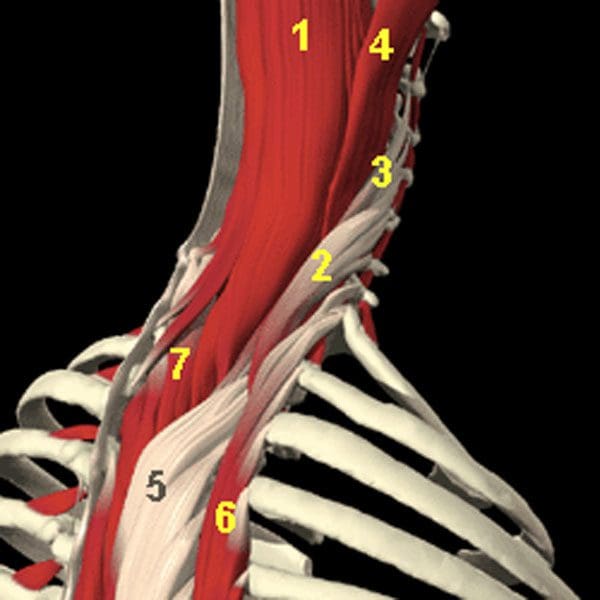
Muscles of the Spinal Column
Cervical muscles
| Cervical Muscles | Function | Nerve |
| Sternocleidomastoid | Extends rotates the head and flexes the vertebral column | C2, C3 |
| Scalenus | Flexes and rotates the neck | Lower cervical |
| Spinalis Cervicis | Extends and rotates the head | Middle/lower cervical |
| Spinalis Capitus | Extends and rotates the head | Middle/lower cervical |
| Semispinalis Cervicis | Extends and rotates the vertebral column | Middle/lower cervical |
| Semispinalis Capitus | Rotates the head and pulls backward | C1-C5 |
| Splenius Cervicis | Extends the vertebral column | Middle/lower cervical |
| Longus Colli Cervicis | Flexes the cervical vertebrae | C2-C7 |
| Longus Capitus | Flexes the head | C1-C3 |
| Rectus Capitus Anterior | Flexes the head | C2, C3 |
| Rectus Capitus Lateralis | Bends the head laterally | C2, C3 |
| Iliocostalis Cervicis | Extends the cervical vertebrae | Middle/lower cervical |
| Longissimus Cervicis | Extends the cervical vertebrae | Middle/lower cervical |
| Longissimus Capitus | Rotates the head and pulls backward | Middle/lower cervical |
| Rectus Capitus Posterior Major | Extends and rotates the head | Suboccipital |
| Rectus Capitus Posterior Minor | Extends the head | Suboccipital |
| Obliquus Capitus Inferior | Rotates the atlas | Suboccipital |
| Obliquus Capitus Superior | Extends and bends the head laterally | Suboccipital |
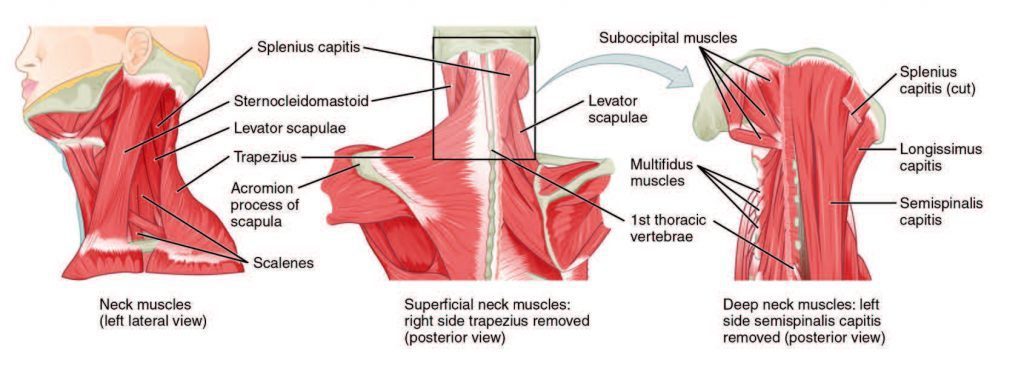
Thoracic Muscles
| Thoracic muscles | Function | Nerve |
| Longissimus Thoracis | Extension, lateral flexion of the vertebral column, and rib rotation | Dorsal primary divisions of the spinal nerves |
| Iliocostalis Thoracis | Extension, lateral flexion of the vertebral column, and rib rotation | Dorsal primary divisions of the spinal nerves |
| Spinalis Thoracis | Extends the vertebral column | Dorsal primary divisions of the spinal nerves |
| Semispinalis Thoracis | Extends and rotates the vertebral column | Dorsal primary divisions of the spinal nerves |
| Rotatores Thoracis | Extends and rotates the vertebral column | Dorsal primary divisions of the spinal nerves |
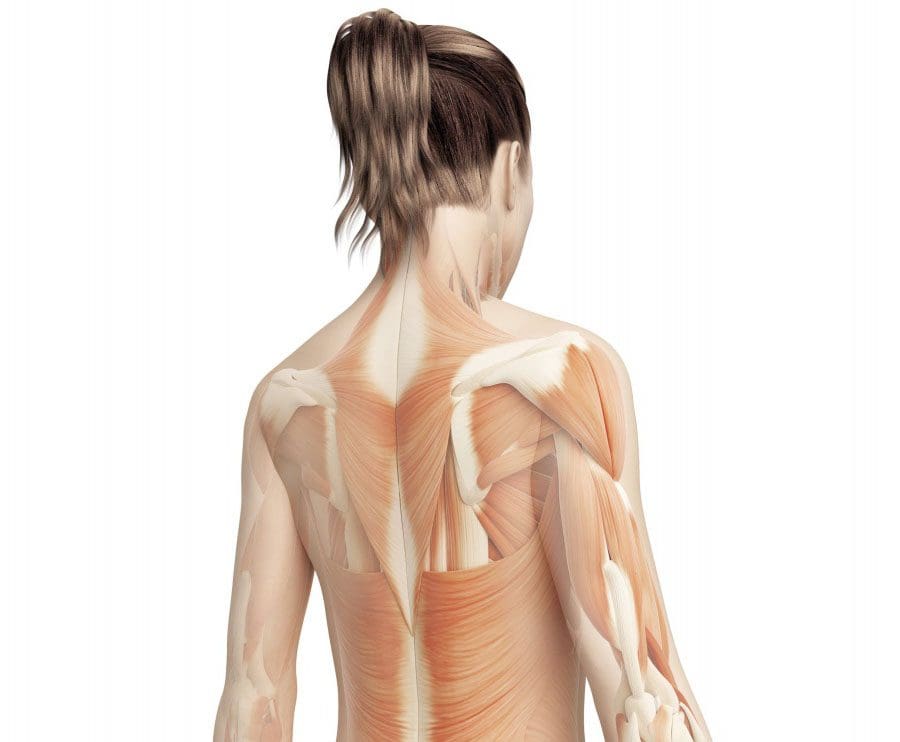
Lumbar muscles
| Lumbar muscles | Function | Nerve |
| Psoas Major | Flexes the thigh at the hip joint and the vertebral column | L2, L3, sometimes L1 or L4 |
| Intertransversarii Lateralis | Lateral flexion of the vertebral column | The ventral primary division of the spinal nerves |
| Quadratus Lumborum | Lateral flexion of the vertebral column | T12, L1 |
| Interspinales | Extends the vertebral column | Dorsal primary divisions of the spinal nerves |
| Intertransversarii Mediales | Lateral flexion of the vertebral column | Dorsal primary divisions of the spinal nerves |
| Multifidus | Extends and rotates the vertebral column | Dorsal primary divisions of the spinal nerves |
| Longissimus Lumborum | Extends and rotates the vertebral column | Dorsal primary divisions of the spinal nerves |
| Iliocostalis Lumborum | Extension, lateral flexion of the vertebral column, and rib rotation | Dorsal primary divisions of the spinal nerves |
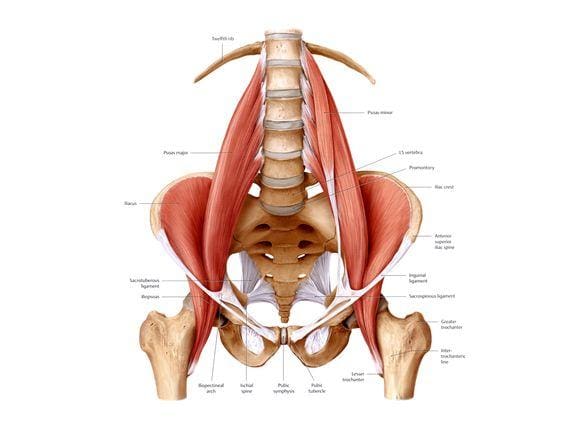
Muscle Fascia Fibrous Tissue
- Fascia is the thickened connective tissue that surrounds a muscle or muscle group. Superficial fascia is directly under the skin.
- Epimysium surrounds the skeletal muscle.
- Perimysium is the sheath that groups the muscle fibers into bundles.
- Endomysium is another type of connective tissue that sheaths each muscle fiber.
The cause of back pain and spinal muscle spasm/s can be caused by overuse, automobile accident, personal, work, or sports injury. The root cause of muscle spasm/s is usually a consequence of an injury to a structure within the lumbar spine. If there have been one or more episodes of muscle spasm in the low back, chances are it will re-occur. The muscles in the low back work together with the abdominal muscles. The spinal muscles add stability by maintaining an erect spine and maintaining balance.
Back Pain Specialist
Post Disclaimer
Professional Scope of Practice *
The information on this blog site is not intended to replace a one-on-one relationship with a qualified healthcare professional or licensed physician and is not medical advice. We encourage you to make healthcare decisions based on your research and partnership with a qualified healthcare professional.
Blog Information & Scope Discussions
Welcome to El Paso's Premier Wellness and Injury Care Clinic & Wellness Blog, where Dr. Alex Jimenez, DC, FNP-C, a board-certified Family Practice Nurse Practitioner (FNP-BC) and Chiropractor (DC), presents insights on how our team is dedicated to holistic healing and personalized care. Our practice aligns with evidence-based treatment protocols inspired by integrative medicine principles, similar to those found on this site and our family practice-based chiromed.com site, focusing on restoring health naturally for patients of all ages.
Our areas of chiropractic practice include Wellness & Nutrition, Chronic Pain, Personal Injury, Auto Accident Care, Work Injuries, Back Injury, Low Back Pain, Neck Pain, Migraine Headaches, Sports Injuries, Severe Sciatica, Scoliosis, Complex Herniated Discs, Fibromyalgia, Chronic Pain, Complex Injuries, Stress Management, Functional Medicine Treatments, and in-scope care protocols.
Our information scope is limited to chiropractic, musculoskeletal, physical medicine, wellness, contributing etiological viscerosomatic disturbances within clinical presentations, associated somato-visceral reflex clinical dynamics, subluxation complexes, sensitive health issues, and functional medicine articles, topics, and discussions.
We provide and present clinical collaboration with specialists from various disciplines. Each specialist is governed by their professional scope of practice and their jurisdiction of licensure. We use functional health & wellness protocols to treat and support care for the injuries or disorders of the musculoskeletal system.
Our videos, posts, topics, subjects, and insights cover clinical matters and issues that relate to and directly or indirectly support our clinical scope of practice.*
Our office has made a reasonable effort to provide supportive citations and has identified relevant research studies that support our posts. We provide copies of supporting research studies available to regulatory boards and the public upon request.
We understand that we cover matters that require an additional explanation of how they may assist in a particular care plan or treatment protocol; therefore, to discuss the subject matter above further, please feel free to ask Dr. Alex Jimenez, DC, APRN, FNP-BC, or contact us at 915-850-0900.
We are here to help you and your family.
Blessings
Dr. Alex Jimenez DC, MSACP, APRN, FNP-BC*, CCST, IFMCP, CFMP, ATN
email: coach@elpasofunctionalmedicine.com
Licensed as a Doctor of Chiropractic (DC) in Texas & New Mexico*
Texas DC License # TX5807
New Mexico DC License # NM-DC2182
Licensed as a Registered Nurse (RN*) in Texas & Multistate
Texas RN License # 1191402
ANCC FNP-BC: Board Certified Nurse Practitioner*
Compact Status: Multi-State License: Authorized to Practice in 40 States*
Graduate with Honors: ICHS: MSN-FNP (Family Nurse Practitioner Program)
Degree Granted. Master's in Family Practice MSN Diploma (Cum Laude)
Dr. Alex Jimenez, DC, APRN, FNP-BC*, CFMP, IFMCP, ATN, CCST
My Digital Business Card


